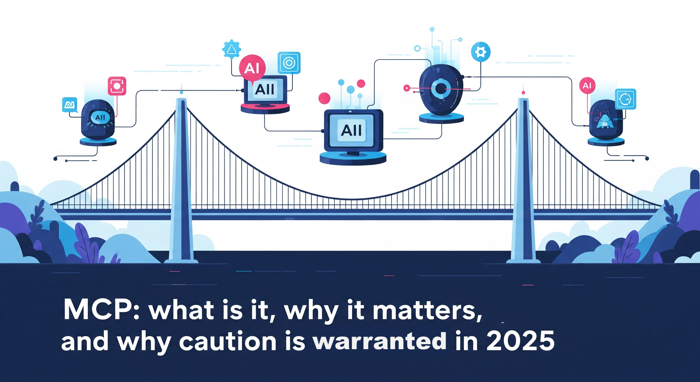In late 2024, Anthropic introduced the Model Context Protocol (MCP) — a new way for AI agents to interact with tools and data through standardized interfaces.
MCP has generated excitement across developer communities, especially for its promise to streamline how agents connect to external services.
But it’s also sparked debate, including among API experts and engineering leaders, about whether it’s mature or secure enough for wide adoption.
In this post, we’ll explain what MCP does, where it’s useful, and where it falls short — especially for developers trying to build reliable and secure AI applications and systems.
Today’s AI agents are limited by how they interact with APIs and external tools.
Most integrations require custom code, brittle scripts, or predefined workflows.
MCP proposes a reusable approach for agent-tool interaction via a standard JSON interface.
MCP aims to make it easier to:
- Expose internal tools to agents without custom wrappers
- Standardize how agents interact with APIs or file systems
- Create agent workflows that chain together multiple tools
This reduces integration overhead and allow developers to plug new tools into agent systems faster.
At its core, MCP follows a client-server architecture:
- The MCP client, often embedded inside the AI agent, sends requests.
- The MCP server exposes tools or APIs in a consistent, machine-readable way.
- Communication happens over JSON-RPC 2.0, with calls like
read_file,run_tool, etc.
MCP is model-agnostic and open-source, which makes it appealing to developers trying to standardize their tool interface layer.
Despite the appealing goals, some in the developer and API ecosystem remain cautious — and for good reason.
When we first reviewed MCP, we noted that it wasn't a formal protocol specification in the expected sense.
Many of the early discussions lived across example code and GitHub discussions, making it difficult to sort through.
Additionally, it's important to note MCP's governance structure and standardization process is still evolving under the leadership of Anthropic, and the future governance structure is uncertain.
One major concern came to light in a recent GitHub issue, where a misconfigured MCP server exposed internal tools to broader access than intended.
This wasn’t classic prompt injection — it was a permissions scope issue that stemmed from how tools were described and invoked by agents.
Developers rushing to add MCP to their systems often don’t fully isolate or sandbox access.
This creates a real risk, especially when AI agents are granted open-ended access to internal operations.
In practice, over half of MCP tools today just expose documentation or basic static data.
Some experts argue that simpler alternatives already exist:
- Direct HTML parsing by LLMs
- LLMs.txt (a markdown-based context file format)
- OpenAPI + cURL for structured endpoint interaction
These approaches are often more efficient and require fewer moving parts.
We expect more innovation to happen in this space, and we're keeping a close eye on it. Here's what's most interesting to us today:
- Enterprise automation, where internal tools are otherwise hard to expose via APIs
- AI-assisted coding, where context-aware tools can be dynamically invoked
- AI agent frameworks and low-code agent builders, like Mastra and Gumloop where support of MCP is enabling faster, more dynamic agent-powered applications.
- Additional emerging protocols, like CopilotKit's AG-UI for making user-agent interaction more accessible for the frontend, and Google's A2A protocol for agents interacting with other agents.
We're hopeful to see MCP and other emerging protocols continue to mature as they're more widely adopted.
All things considered, if you're a developer working on AI agent infrastructure, MCP is promising.
As with any emerging technological development, it’s important to treat it with an experimental mindset.
MCP is still evolving, security practices are immature, and real-world value is still being proven out at meaningful scale.
In our view, MCP needs more of the rigor we've been applying to API specs and standards over the last two decades.
Before adopting it, we recommend developers:
- Read the full spec (modelcontextprotocol.io)
- Review security boundaries carefully
- Don’t expose sensitive tools without strict permission controls
- Consider if direct integrations are more practical
MCP is an ambitious attempt to rethink how AI agents interact with the world, and that’s worth exploring.
We encourage developers to test, share feedback, and improve the ecosystem - and to go in with eyes open.
How is MCP different from OpenAPI?
MCP is runtime-focused — agents call tools dynamically. OpenAPI is more declarative and often used to generate client libraries or documentation. The two can complement each other.
Is MCP secure?
It depends heavily on how it’s implemented. The protocol itself doesn’t enforce access control — that’s up to the developer.
What happened with the GitHub security issue?
A reported case showed that an MCP server granted broader access than intended.
The root issue was a lack of scoped permissions in how tools were defined and invoked.
Is MCP necessary?
Not always. For many use cases, standard API calls or context injection via other formats may be more practical.
